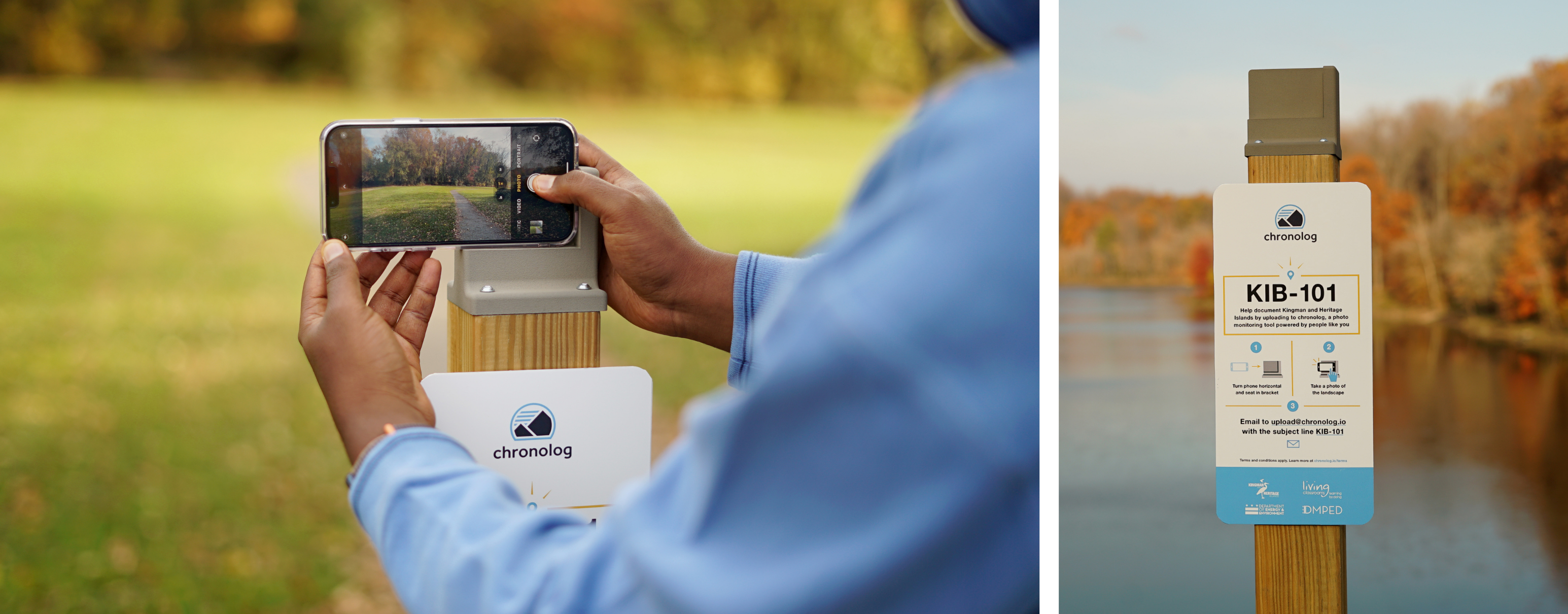Guest post by Jake Rose
Changes in forest health generally happen gradually. Invasive species, for instance, tend to spread slowly through a forest, little by little, year by year, crowding out native plants and animals. Even after a sudden disruption to forest health, like a severe wildfire, it’s not uncommon for forested ecosystems to take decades to recover.
Because most of the changes that occur in forests happen incrementally over many years, it can be a challenge to map and measure those changes at scale across parks, nature preserves, and other community green spaces. But what if outdoor recreators—who already frequent these places—were able to help with monitoring for forest health? That’s the aim of Chronolog.

Chronolog is a new community/citizen science project that helps researchers and land managers install photo stations at environmentally significant locations. Using a photo station (pictured above), any citizen scientist can take photos from a standardized point of view and submit them to be included in a crowd-sourced time lapse.
Crowd-sourced time lapses (like the one below) not only create new phenological records, they also involve the public in the scientific process. The effects of erosion, prescribed fire, invasive plant species, or changes in seasonal patterns can be told through a visual story, and by submitting personal photos, the public becomes a part of that story.
Citizen science projects like Chronolog are proven to help boost scientific literacy. Whether a visitor snaps a photo record at a photo station or just spends a few minutes browsing photo inventory online, chances are good they will leave the experience having learned something about forests or forest health monitoring.
Each photo submitted also helps environmental educators to show and not just tell how the Earth is in a constant state of change. Forestry professionals, school teachers, and landowners—all of whom can be environmental educators—can use the time lapses to explain the benefits of forestry practices, like prescribed fire and sustainable timber harvesting, as well as the effects of forest threats, like rising sea levels and invasive species.
To give you a taste of what we mean, check out this case study:
The Dyke Marsh Wildlife Preserve, a 485-acre preserve managed by the National Park Service, has been the focus of a native plant restoration project since 2018. At the project’s start, the preserve’s upland forest was overrun with non-native plants that were causing trouble for both native plant and wildlife species.
In 2018, Friends of Dyke Marsh (FODM), in partnership with the National Park Service, Earth Sangha, and the Audubon Society of Northern Virginia, planted 4,000 native plants in the restoration area, a .65-acre plot on the west side of the Haul Road trail. Throughout the following spring, summer, and fall, FODM had regular volunteer sessions to control non-native plants like mile-a-minute (Persicaria perfoliata) and Japanese stiltgrass (Microstegium vimineum). By October 2019, FODM volunteers and National Park Service staff had planted 400 more native plants within the restoration area, including riverbank wild rye (Elymus riparius), New York ironweed (Vernonia noveboracensis), wild rice (Zizania aquatica) and deer tongue (Dichanthelium clandestinum (syn. Panicum clandestinum)).
FODM has been able to quantify the effectiveness of their native plant restoration effort with the Chronolog monitoring project. Volunteers were able to see which plants were gradually returning and the difference in the forest canopy each summer, too. Already, the lessons learned from this time lapse have affected how future restoration projects are planned.
Anyone can use the Chronolog website and photo time lapses for free. If you are interested in becoming a Chronolog organizer and setting up a photo station near you, there is an annual cost. Click here to learn more.
Jake Rose is the coordinator for Chronolog. He can be reached at jake@chronolog.io.

